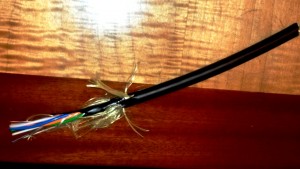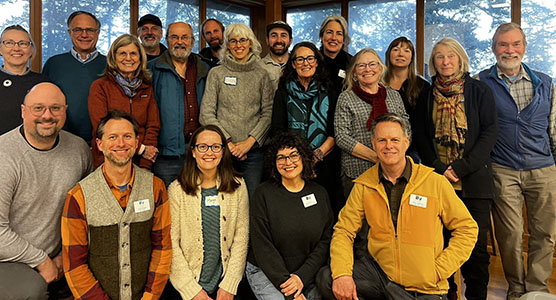By Margie Doyle
Think of “broadband” as a highway, OPALCO spokesman Jay Kimball told some 100 Orcas Islanders who attended the Broadband Forum on June 19 at the Orcas Senior Center; he then proceeded, with OPALCO’s J. Foster Hildreth, Assistant General Manager, and Board President Chris Thomerson, to take the audience on a trip down that highway.
The audience included folks who are familiar with computers, internet and the World Wide Web but are trying to weave their understanding with terms like videostreaming, cellular reception, internet service providers (ISP), bandwidth, fiber optics and the like into a “whole cloth” understanding of the broadband coverage issue addressed by OPALCO, an electricity-providing cooperative with some 12,000 members county-wide.
Also included in the audience, which filled the Lundeen Room at the Senior Center, were folks who have been instrumental in expanding internet capacity in other communities, and who have purchased private broadband expansion for their own businesses, and local ISPs such as Orcas Online. Their input helped guide the conversation as it ranged from comments to complaints to concerns and questions.
Q: How/where do you get broadband?
When you get anything over the internet, it’s coming to you via broadband 99 percent of the time. Broadband does not include dial-up connections. Broadband is received over your radio, televison, computer, dsl, cable, and wireless systems through a device such as a modem.
Q: What is OPALCO proposing now that is different from its broadband initiative put out in January of this year?
Earlier this year, a hybrid fiber and wireless broadband system was proposed to reach individual homes and businesses through 90 percent of SJ County. The cost was estimated at $34M, to be paid for through OPALCO membership ($15/month) and broadband subscribers ($75/month). The business plan required at least 5,800 subscribers and OPALCO was asking members to pre-subscribe with a $90 deposit.
The initiative resulted in about 900 pre-subscription deposits before the sign-up process was closed on May 3st. It became clear that the subscription goal would be challenging to achieve and, at the same time, the plan brought some new opportunities to the table.
At the public forums, June 12-19 on San Juan, Shaw, Lopez and Orcas Islands, OPALCO staff explained the new direction would position OPALCO as an infrastructure provider – working with CenturyLink, Rock Island, Orcas Online, The Computer Place and Island Network to improve service to the county.
OPALCO will enter into lease arrangements with the Internet Service Providers (ISPs), who would pay to expand OPALCO’s data communications infrastructure to make broadband service available to their customers. Individual home- or business- owners would then arrange for the improved service from the ISPs.
For example, CenturyLink’s current system utilizes copper cables from the central offices to distribution cabinets around the island. Additional copper cables deliver the phone and Internet signals from the distribution cabinets to each home/business. OPALCO proposes to lease and install fiber optic cables from the central offices to the distribution cabinets – which would eliminate the major bottle-neck issues for most of San Juan County. The “last mile” of copper from the distribution cabinets to each home/business would still be a limitation: those located more than 15,000 feet from the distribution cabinet may still be challenged – but the local ISPs will be able to offer broadband solutions to reach those outer addresses through leasing agreements with OPALCO as well.
This “infrastructure provider” approach is estimated to cost $3-5 million.
Q: Explain the difference between fiber and copper connections
Fiber optic cables, as shown in the photo at right, move data and information as light through the glass strands. Capacity and speed are not limited by the material; the devices that push the data can be upgraded and increase capacity as needed. Copper has greater limitations: it has limited linear reach, a saturation point for capacity and also degrades over time in the ground. Terry O’Sullivan suggested we think of “copper as the little red straw you stir your coffee with – and fiber as a fire hose in comparison.”
Q. Do you think CenturyLink will want to partner with OPALCO in offering this service?
CenturyLink is in negotiations with OPALCO and a lease agreement is expected by end of summer. In addition to the lease agreement, service improvements would require additional investment on CenturyLink’s part. Some members in attendance at the meeting questioned CenturyLink’s willingness to make such an investment. Also, the relatively small number of county customers who would benefit from such an investment may not provide a sufficient cost-effective rationale for CenturyLink to make such an investment.
“We can’t guarantee CenturyLink’s level of service; we can make sure the infrastructure is in place; whether they perform is up to them,” said Hildreth.
Regardless, OPALCO will provide the infrastructure of linking its fiber optics network to any and all of the local Internet Service Providers, who will be able to improve broadband services to their customers.
Bob Gamble encouraged the OPALCO board to help other ISPs to improve wireless systems and provide “real competition” that will goad CenturyLink “to follow through. Competition is the only thing that brings improvement.”
Hildreth responded, “My suspicion is that [OPALCO] membership will demand we stay very active in increasing broadband.”
Q: I’m concerned that Emergency Medical Service (EMS) coverage is limited in more remote areas of the islands.
As an electricity provider, OPALCO staff at headquarters need to be in contact with crews in the field; just as medical facilities and staff need to be in contact with emergency medical providers. The recent mock-emergency drill in Deer Harbor showed that communications were the weak link, proving that there is a need “to get everybody on one communication system.”
Patrick Shepler of the Orcas Fire and Rescue Department said that OPALCO is not always thought of “as a component of emergency services. But it is a first responder and has a vision for public safety… countywide.”
Q: I’m concerned that, while OPALCO plans to sell improvements to providers, such as CenturyLink, those improvements won’t be passed on to the customers.
“We have faith that if we provide the tools, CenturyLink will improve service if we make it economically feasible. If we can provide more competition than they have, then they’d be motivated to improve,” said Hildreth. “Also, if CenturyLink doesn’t rise the occasion, the local ISPs will.”
Q. How will you handle requests to upgrade to fiber and to increase capacity?
OPALCO will work with the ISPs on the overall effort; a schedule of lease rates and infrastructure is currently being worked up.
When asked, Rick Boucher of OrcasOnline enthusiastically endorsed the plan to lease fiber optics from OPALCO in order to improve wireless service for “the final mile” to OrcasOnline customers.
Q: What is the Island Network? Will you keep it going?
The Island Network is a division of OPALCO that sells the excess capacity of its fiber network, installed in 2001, to larger members: county government, fire departments, schools, schools, libraries, law enforcement. It is a fiber optic connection that was also offered to private individuals and businesses. It connected 27 Orcas Island entities, including Ray’s Pharmacy, at a cost borne by the requesting entity. Now there is a moratorium on providing Island Network connections until the pricing structure and build-out plans are determined.
Q. Is there a plan for OPALCO to get fiber out to all island houses?
That was the very first consideration in expanding OPALCO’s fiber optic network to its co-op members. However, the cost, estimated at $75 million, was prohibitive.
Now, OPALCO is on constant lookout to deploy its fiber optic system. For example, it always puts conduit in open ditches. It also looks at all funding sources that arise. OPALCO’s endgame at this point is to replace the copper network with fiber as much as is possible, and then to work with ISPs who provide wireless service to households.
Q. Has OPALCO looked at government and grant funding sources?
A funding study was conducted during the feasibility phase and government and grants were explored.
As a co-op, OPALCO enjoys a favorable, low-interest Federal borrowing rate that gives it some leverage to build these broadband facilities at a lower rate than other telecommunications companies can get. Those reductions can be passed along.
OPALCO’s pricing structure is always the cost of service; lease costs will be passed along to the customer.
Q. Does increased broadband have the ability to stream video to television and computers?
OPALCO’s broadband infrastructure allows for applications such as video streaming; it can be accommodated easily and in great quantity
Q. Who makes the decision on this new approach?
OPALCO is now talking about providing services to local ISPs. The OPALCO Board reviews and approves lease arrangements and infrastructure planning and implementation schedules.
Q. What can we do as a co-op to make broadband enhancement happen faster?
Co-op members can request that their ISPs increase fiber. OPALCO’s Island Network can be expanded to create “fiberhoods” where neighborhoods pool their resources to bring fiber directly to their homes, or to a local end point from which the ISPs can provide expanded wireless service.
The OPALCO new direction is to incrementally to expand its infrastructure reach to provide OPALCO members with access to better broadband.OPALCO concedes that capacity won’t be accomplished as quickly as with the previous plan, but it will cost a lot less money and, as an open network, will give all of the ISPs a chance to benefit from the system.
Q. Is there a map and timeline of where growth will happen?
Not yet. OPALCO is working on the overall design and engineering for the new direction at the same time that lease agreements are in process. Once information is available, it will be posted online at www.opalco.com/broadband.
**If you are reading theOrcasonian for free, thank your fellow islanders. If you would like to support theOrcasonian CLICK HERE to set your modestly-priced, voluntary subscription. Otherwise, no worries; we’re happy to share with you.**









Very clear, easy to understand article Margie. Thank you! It really helped! Spirit Eagle
Do you know if there is a map of the current locations of CenturyLink’s distribution cabinets that could be made available to islanders?